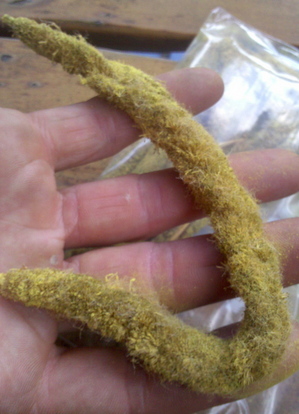Combine wild foods with ice cream and make a sweet treat more fun

Cattail pollen on ice cream? An unusually wonderful experience.
Linda Diane Feldt | Contributor
Foragers have a reputation for being extremists and purists. It isn’t necessarily so. My latest creative thoughts on how to use the foods I forage has been answering the question, “What would go well with ice cream?”
It started with a walk in the woods that just happened to occur on vacation, as I was indulging in an ice cream cone. I came across some yellow violets (Viola biflora). I know, that seems like a contradiction, but they exist.
It seemed like a good idea at the time to pick them and cover the ice cream with them. I tend to favor chocolate, so the yellow flowers against the dark brown rich treat were really pretty. And tasted great.
It’s berry season, so naturally smashing black raspberries, mulberries, serviceberries or red raspberries into a bowl of ice cream has been a fun way to serve up a special desert for friends. That's especially true when the berries are just a few minutes off the tree or cane, but frozen berries will also go well later in the year.
If you make your own ice cream, fresh fruit is a must. And not just berries: Later we’ll have apples, pears, apricots and all sorts of tree fruits that can be used.
This weekend I’m trading fresh berries with someone who makes her own ice cream. I supply the berries and then get some of the ice cream she makes from them in return. That seems like an excellent trade.
If you make jams and jellies from wild fruit, they can end up as a topping as well. A little sweet for my taste, so a little goes a long way.
Wild nuts and seeds can also be enjoyed in ice cream. Hickory nuts, black walnuts and other tree nuts end up in tiny pieces anyway. Just sprinkle them on your favorite flavor.
What sorts of seeds can you use? Here are two unusual ones. How about fresh or dried staghorn sumac (Rhus typhina) berries? They give a lemony taste and fuzzy texture. Or how about the nutty-flavored seeds from jewel weed (Impatiens glandulifera and others)? You can harvest those by carefully picking the seed pod and then letting it explode in your hand. Combine exploding food with ice cream, and I think most kids would be enthusiastic about a trip out to the woods.
Of course flowers are where this all started. Chicory (Cichorium intybus) flowers are available right now and are a lovely blue with a mild taste. While the peppery tasting flowers would be a problem (nasturtiums), as well as the mustards and onions, any slightly sweet flower (lilac, honeysuckle, red clover) would be especially nice. The clover can be shredded for better appeal.
For a sublime experience, cattail pollen lightly sprinkled over nearly any flavor (but vanilla and chocolate are especially perfect) adds a beautiful color, and a most delicate, almost surreal taste. It’s like eating gold. Or at least I imagine that’s what gold should taste like. I don’t recommend putting metal on food, actually.
Does it work with ice cream cones? I’ve layered berries and ice cream into a cone; it works better to let the ice cream soften, mix in what you want, and then let it re-freeze just a bit so it will hold shape. But in a hurry, just smoosh them into place and enjoy.
As an alternative, all of these ingredients can be used in smoothies as well, either mixed in or as a garnish. My “smoothies” are rarely smooth, but lumpy with nuts and seeds.
I hope that provides some inspiration and ideas. There is a balance of walking and moving and then enjoying a sweet treat. When you come back home after a hot afternoon of foraging, ice cream can be just right.
Next June I’d love to see people filling up on ice cream at Kilwin’s downtown, then walking over to Washington and Fifth to add ripe serviceberries to their cones or dishes. That would be a wonderful downtown experience.
Linda Diane Feldt is a local Holistic Health Practitioner, Writer, and teacher. You can follow her on twitter, visit her website, or contact her directly ldfeldt (at) holisticwisdom.org. This Saturday afternoon, July 16, she’ll be presenting a free class as part of the Transition Town Reskilling Festival. The topic is Preserving, Preparing and Enjoying What You Harvest. Her book “Spinach and Beyond: Loving Life and Dark Green Leafy Vegetables” will also be available for sale at the festival.

